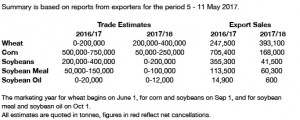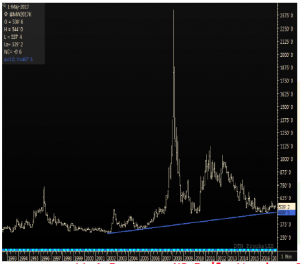- Soybean futures break down In technical trade, following last week’s break to the downside, soybean futures shrugged off old crop export demand and extended losses in Monday’s trading. Ahead of the morning open, the USDA announced an export sale of 130,000 mtof old crop soybeans to an unknown destination. After the close, NASS reported national planting progress at 67% complete, versus 53% last week and the five year average of 68%. MN is leading the Cornbelt states with 81% of it’s crop in the ground, trailed by IA at 77%. IN and OH were each at 54% complete, and both states were 17 points behind their five year averages. 37% of the US soybean crop was reported emerged, just behind the average of 40%. Old and new crop soybean contract’s are now deeply oversold, with funds sitting on the largest net short position in over a year while hedgers are still holding a rare net long position. Support should be found in July ’17 futures around or just below $9.00/bu.
- Corn falls on weather; crop rating lower than expected: Somewhat expectedly, Chicago futures start the summer season lower on a modestly improved US forecast. Additional soaking rain is absent through the next 10 days, and temperatures will eventually reach into the mid/upper 70s across much of the Corn Belt by mid-July. Planting and emergence dates continue to track close to normal, though crop conditions provide evidence of this season’s less than ideal start to the growing. Funds are estimated to hold a net short in Chicago worth 193,000 contracts. The US crop is rated at 65% good/excellent vs. 72% a year ago and the lowest since 2011. Ratings are decent across the Plains and W Corn Belt, but are concerning in the East. IL’s crop is pegged at 52% good/excellent, down 19% from last year, IN’s crop is pegged at 43% good/excellent, down 26% from last year, and work suggests without improvement US yield potential is no better than trend. In the primary corn belt, only NE conditions are better than last year. We also mention that Gulf corn for spot delivery is priced at parity with S American origin, and ethanol margins have rebounded quickly following the break in corn.
- Wheat ends down; world cash market still firm. Wheat futures followed corn and soybeans to moderate losses, though as the US dollar weakens Gulf wheat remains competitive in the world market for spot delivery. Russian cash prices have rallied slightly and origination issues persist, and Gulf SRW is not only the world’s cheapest origin, but also holds a sizeable discount to EU and Black Sea wheat. US wheat crop conditions remain well below last year. Winter wheat conditions fell 2 points to 50% good/excellent vs. 63% on this week a year ago. Declines of 4-5% are noted across the Plains, and early harvest results continue to feature very low protein levels. Spring wheat is rated at 62% good/excellent vs. 79% a year ago and the lowest in late May since 2008. We remain somewhat concerned about high protein wheat availability. There is also increasing concern about developing drought in E Ukraine, where 30-day rainfall in some areas now rests at 20-40% of normal. Record old global stocks must be worked through, but increasingly wheat is viewed as cheap below $4.20, spot Chicago, as N American weather has been far from ideal, and as for the first time in years the US is competitive with Europe for summer export demand. Egypt released its first tender for new crop supply this afternoon, the results of which will be watched closely by cash traders on Wednesday



